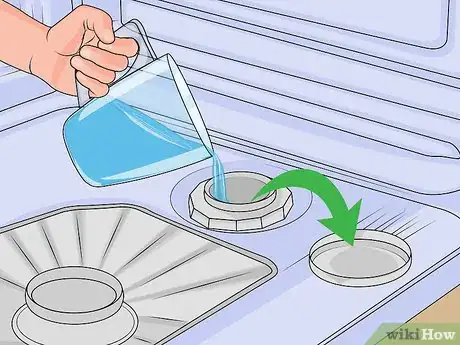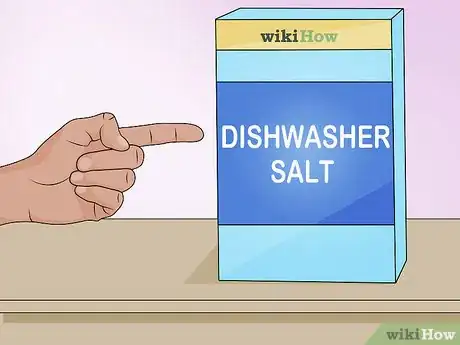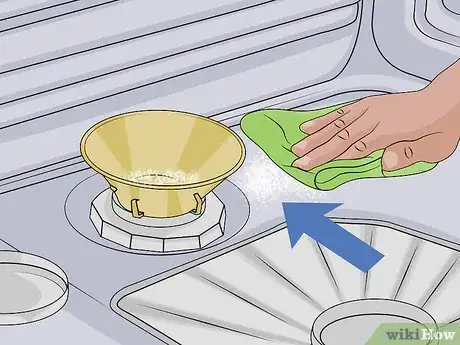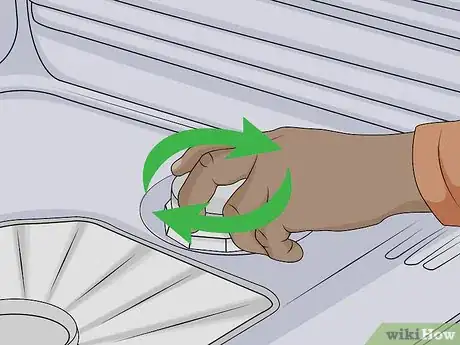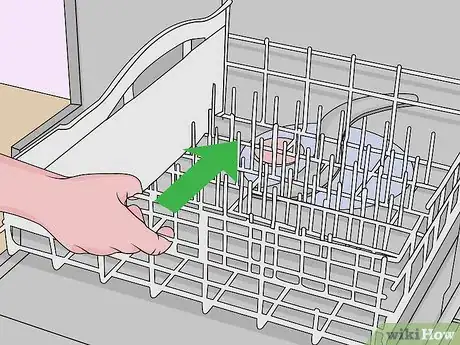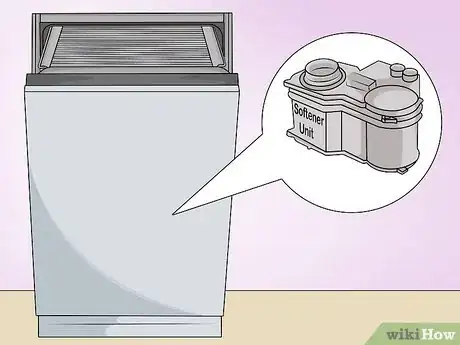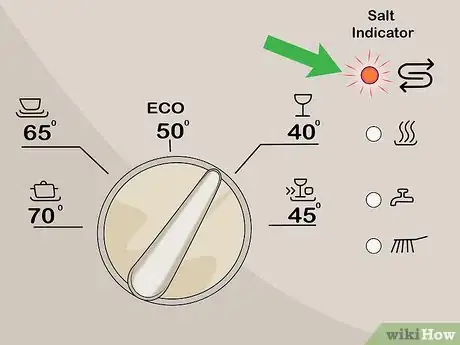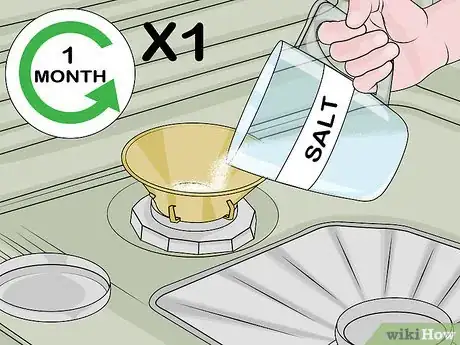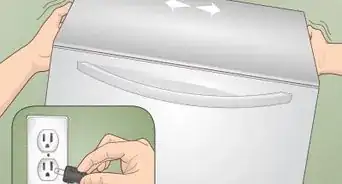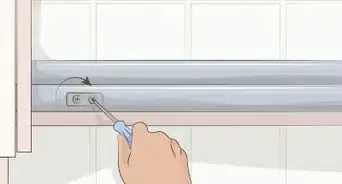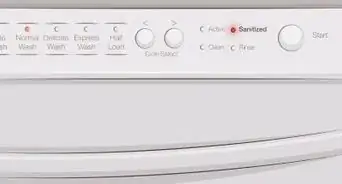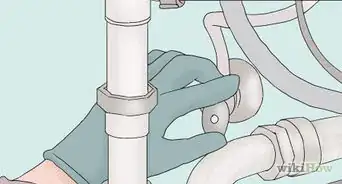This article was co-authored by wikiHow Staff. Our trained team of editors and researchers validate articles for accuracy and comprehensiveness. wikiHow's Content Management Team carefully monitors the work from our editorial staff to ensure that each article is backed by trusted research and meets our high quality standards.
wikiHow marks an article as reader-approved once it receives enough positive feedback. In this case, 89% of readers who voted found the article helpful, earning it our reader-approved status.
This article has been viewed 466,546 times.
Learn more...
Dishwasher salt can be added relatively easy to most dishwashers in order to ensure that your dishes come out clean and sparkling! This type of salt is specially formulated to soften hard water, which can cause dishes to appear dirty or be covered by a thin layer of minerals, even after washing. In many places, especially in the UK and much of Europe, dishwashers come with a built-compartment where your salt goes. Using it is a matter of checking to see if this compartment needs more salt and then refilling it as necessary.
Steps
Putting Dishwasher Salt in Your Dishwasher
-
1Remove the bottom rack to expose the salt reservoir. Pull the bottom rack out completely and set it on your kitchen counter. You may need to lift it up slightly to unclip it from its rollers. Your reservoir will be on the bottom of the dishwasher, probably off to one side. If you don’t see a reservoir, your dishwasher may not have a built-in water softener.[1]
-
2Unscrew the cap and check for water. Water softener units have caps that need to be tightly secured after each use. Unscrew this cap and set it to the side. If this is the first time you’re using your unit, it needs to be filled with water. Pour enough in to fill it to the top of the opening.
- After the first time you use it, your softener unit should always have a bit of water in it. You won’t need to refill it.
Advertisement -
3Use only dishwasher salt in your softener unit. You can find specially made dishwasher salt at grocery stores, hardware stores, or online. It doesn’t matter which brand of you choose, but you cannot use table salt, sea salt, or kosher salt as a replacement for dishwasher salt. These cooking salts contain additives that might actually increase the hardness of your water. They may also be too fine, which could clog the unit.[2]
-
4Pour salt into the funnel until the reservoir is full. Different dishwashers will have differently sized units that take various amounts of salt, so there’s no precise measurement for this process. Pour salt into the unit until it’s completely filled up. Since you also have water in the unit, you’re creating a saltwater brine that will refresh the chemical processes that occur in the built-in softener.[3]
- Using a funnel to pour your salt will help you avoid spills. Hold the funnel above the reservoir instead of plunging it into the unit. If the funnel gets wet, the salt won’t pour through it properly.
-
5Clean excess salt with a wet cloth. If you’ve spilled any salt in the dishwasher around the unit, wipe it up with a wet cloth. The salt you pour in the softener unit never actually touches your dishes, as it just stays in the unit itself. If you leave loose salt in the dishwasher, however, it will get mixed in with the water that cleans your dishes. This won’t hurt them, but it may give you slightly dirty (or salty) dishes for one cycle.[4]
- You can also run a rinse cycle without dishes to clean any spilled salt out of the dishwasher.
-
6Screw the cap on tightly. Replace the cap securely and check to make sure it’s tight. If the cap gets loose during a cycle and detergent gets into the unit, it could break. You certainly don’t want to pay for a new dishwasher just because your cap wasn’t tight enough![5]
-
7Replace the bottom rack and run the dishwasher normally. Once you’ve checked your cap, you can put the bottom rack back into the dishwasher. Fill your dishwasher with dishes and run it like you always do. There’s no need for an empty rinse or clean cycle after you refill the salt.[6]
Checking if Your Dishwasher Needs Salt
-
1Use salt only in dishwashers that have built-in softener units. If you are unsure whether your dishwasher has a built-in unit, contact your manufacturer. If you can’t find it on the bottom of the dishwasher, you probably don’t have one. Don’t put dishwasher salt into other spots marked for normal detergent or dishwasher cleaner. This could easily break your appliance.
- Most dishwashers in the United States do not have built-in softener units that need to be filled with salt. Only select models come with this feature.[7]
-
2Check your dishwasher’s salt indicator. The easiest way to know if your dishwasher needs more salt is for it to tell you that it’s ready for a refill! Many dishwashers have an indicator light either on the top panel of the dishwasher and/or on the unit itself. If your lights are green, they’re good to go. If your indicator lights are red (or, on the unit itself, clear), then you’re ready to pour in more salt.[8]
-
3Top off the reservoir at least once per month. If your dishwasher doesn’t have indicator lights, it’s up you to make your own schedule. It’s a good idea to refill the salt about once per month in dishwashers that contain built-in units. Even if you have indicator lights, you may want to do a refill if it’s been over a month.[9]
- If you notice that your indicator lights are taking more than a month to tell you to refill the unit, they may be broken. Check your unit levels, and call your manufacturer if you’re concerned.
-
4Top off the reservoir if your dishes appear overly streaky. Monitor your dishes to keep an eye on the water softness. If your water is getting too hard, you’ll start getting streaky dishes that look like they have a white film on them. This will be especially obvious on clear glasses. Top off the reservoir with salt to restore that pretty sparkle to your wine glasses![10]
Community Q&A
-
QuestionI am getting a white film around my glasses. Cleaning my glasses with white vinegar did not help. We do have a water softening system in our home, and that should be helping. What is the problem?
 Community AnswerYour glasses are getting slowly sanded by the powder in your dishwasher. There is nothing you can do to fix it. Using a liquid dishwasher detergent can slow the process, but if you don't want it to happen you have to wash the glasses by hand.
Community AnswerYour glasses are getting slowly sanded by the powder in your dishwasher. There is nothing you can do to fix it. Using a liquid dishwasher detergent can slow the process, but if you don't want it to happen you have to wash the glasses by hand. -
QuestionWhat do I do if I put table salt in my new dishwasher?
 Community AnswerGet as much of it out of the reservoir and clean up what you can; if there is some left, it will not hurt your washer. Table salt will dissolve quicker than dishwasher salt as it is finer. Table salt may not soften your water; however, in small amounts it won't hurt your dishwasher. Once you clear as much of the salt as you can, run a rinse cycle. The salt should be all gone, and you can now add dishwasher salt.
Community AnswerGet as much of it out of the reservoir and clean up what you can; if there is some left, it will not hurt your washer. Table salt will dissolve quicker than dishwasher salt as it is finer. Table salt may not soften your water; however, in small amounts it won't hurt your dishwasher. Once you clear as much of the salt as you can, run a rinse cycle. The salt should be all gone, and you can now add dishwasher salt. -
QuestionDoes my dishwasher reservoir need water at all times?
 Community AnswerIt depends how old and how sturdy you dishwasher is. If it's quite old and does frequently need checking up on, then yes. If not, then no.
Community AnswerIt depends how old and how sturdy you dishwasher is. If it's quite old and does frequently need checking up on, then yes. If not, then no.
Warnings
- Do not put regular dishwasher detergent in your salt reservoir. This could break the appliance.⧼thumbs_response⧽
References
- ↑ https://www.finish.co.uk/features/dishwashing-articles/products/effectiveness-dishwasher-salt/
- ↑ http://www.appliance-care.org.uk/dishwasher-care/daily-use/salt/
- ↑ https://www.finish.co.uk/features/dishwashing-articles/products/effectiveness-dishwasher-salt/
- ↑ https://www.finish.co.uk/features/dishwashing-articles/products/effectiveness-dishwasher-salt/
- ↑ https://www.finish.co.uk/features/dishwashing-articles/products/effectiveness-dishwasher-salt/
- ↑ https://www.finish.co.uk/features/dishwashing-articles/products/effectiveness-dishwasher-salt/
- ↑ http://www.cooksinfo.com/dishwasher-salt
- ↑ http://www.appliance-care.org.uk/dishwasher-care/daily-use/salt/
- ↑ http://www.appliance-care.org.uk/dishwasher-care/daily-use/salt/
About This Article
To use dishwasher salt, first remove the bottom rack in your dishwasher to expose the salt reservoir. Then, unscrew the water softener cap to make sure there’s enough water inside, and top it up if necessary. Pour your salt into the unit until it’s full and wipe up any spillages with a damp cloth so the salt doesn’t contaminate your dishes. Once the unit is full, screw the cap on tightly and replace the bottom rack. Afterwards, load your dishwasher and run it like you always do! For tips on how to know if your dishwasher needs salt, keep reading!

